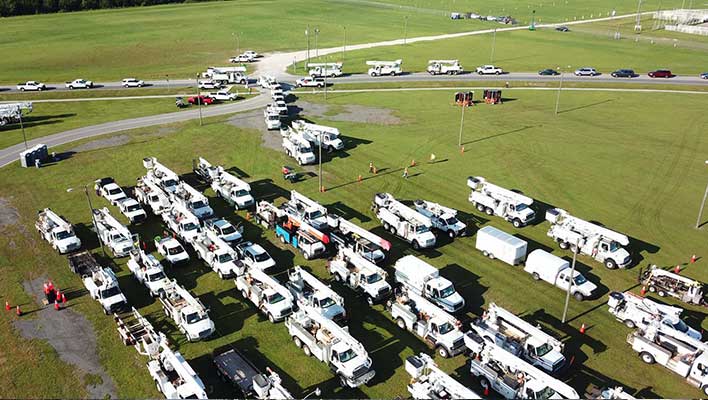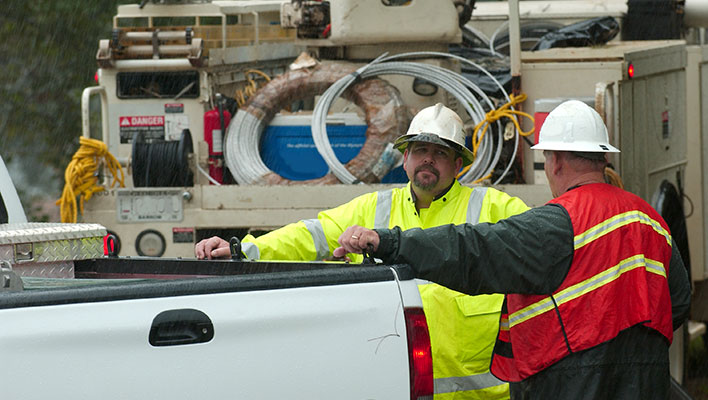A new generation of utility line mechanics in the field and a growing reliance on contractors are leading electric utilities, cooperatives, and municipal providers to expand systems and respond to increasing storm events with fewer people. Jason Singer, Director of Resource Management Services at ARCOS, digs into the tie between generational impact and contractor issues and how ARCOS bridges the resource limitation chasm with mobile workforce and resource management technology to help get work done.
Imagine it’s a Friday summer night when a thunderstorm strikes unleashing a brief yet severe burst of straight line winds. The power is out for a subdivision, there’s line on the ground and a transformer has blown releasing oil. The foreman is franticly placing calls and searching his filing cabinet but can only find a few people to bring in and they are 3 hours away.
10 years ago, teams had more than enough full time employees to resolve a small Friday night outage with relative speed. However, situations when it is nearly impossible to find line workers are increasingly common for many electric utilities, cooperatives, and municipal providers because the industry has necessarily had to rely more and more on contractors. And contractors don’t have to work a 5 day week. In the example above, the native contractors the utility normally called on had vanished after Thursday might, gone fishing, taken a 3-day road trip, anything besides being on call for line work. How did we get here?
The New, Hybrid Workforce
The previous generation of line workers made a career of the electric transmission and distribution industry. They put in 35 years and earned a pension. But that generation is in the midst of full scale retirement, the pensions are gone, and a younger generation is taking over the lines.
The big crew change comes at a time when electric providers are spending more than ever to expand and harden systems all while contending with more frequent and severe weather. Teams must manage more routine and unplanned work with a shrinking workforce as senior linemen retire and are replaced with fewer junior workers. As a result, many teams must manage a hybrid workforce of full time employees and as much as 80% contractors in some cases.
Contractors offer electric providers many benefits, including the ability to scale up and scale down as needed as well as cost savings that come with not having to pay HR benefits. but the link between the new generation and the appeal of contract work has created an unforeseen cost to utilities.
The Big Crew Drain
The electric industry is going to extreme lengths to recruit apprentice workers exiting line school and technical colleges, even sponsoring and paying for their training. Yet increasingly, this new generation stays at an IOU just as long as it takes to achieve journeyman before putting in their t-week notice. Then a month or so later appear on the roster at a contractor company, making the utility the place new line workers go to get trained for their full time contract career.
The grass is always greener on the other side, in this case hard cash. $50 an hour should be ample incentive for a young line worker just starting their career as a full time employee but if they can get paid $100 an hour as a contractor, doubling their rate more than makes up for the lack of benefits. The contractor life is also more consistent with the mindset of the new generation where you can earn enough after working one storm event to take a month long trip to Bali or buy a new truck. Or get paid even more on the West Coast and work only half the year.
Electric providers are not only navigating a big crew change, the big crew drain is also impacting the bottom line by turning a $17M system expansion into a $25M capital project.
Treating Contractors Like Your Own
Contractors are often excluded from direct access to the tech and mobile workforce management solutions of employees, which adds layers of inefficiency. Processes are out of necessity, often heavy on paperwork packets, lack transparency or accountability, and require multiple phone calls to coordinate jobs.
As the industry loses employees and relies more on contractors, processes must change for a hybrid workforce. Many utilities are also changing the narrative, viewing contractors as the business partners they are, opening up mindset to treating partners like their own by giving them access to the same technology to boost performance, improve safety, and elevate job satisfaction.
Today, many utilities, cooperatives, and municipal providers use ARCOS to include contractors in their rosters and callouts. Powering external resource management is Resource Assist, a cloud-based work management solution used to find and schedule contractors. It automates the process of reaching out to large numbers of contractors, verifying availability, and integrating committed external resources into ARCOS solutions like Callout, Crew Manager, and Mobile Workbench.
With ARCOS, teams seamlessly manage a hybrid workforce with the same back office tools for assembling resources and executing callout. Plus, one powerful mobile app for employees and partners to use that tracks their location in real time, delivers digital work packets complete with compatible units, automatically tracks time, and provides detailed feeder maps of the circuits they have access to.
Treating contractors like your own has dividends in terms of field productivity , situational awareness, and job satisfaction that will help your team achieve more with the resources you already have and retain the new generation of line workers you need for the future. By bringing consistency to full time employees and business partners, your team can overcome the generational and resource challenges holding back higher levels of operational excellence and efficiency.
Be sure to read my third and final blog in this series where I’ll explore keys to workforce sustainability.
Did you enjoy Jason’s blog? Check out his previous post: Crossing the Chasm: Not Your Parents’ Utility Anymore




